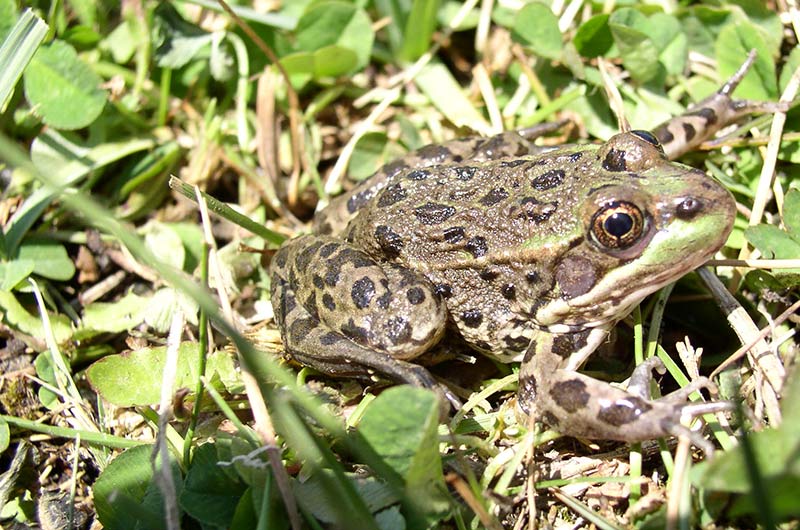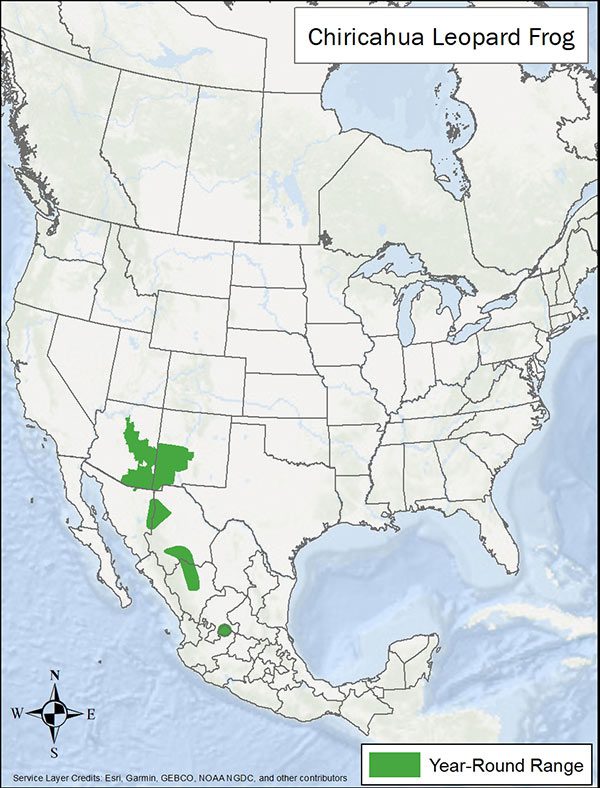LandPKS Learning
Habitat Hub

Chiricahua Leopard Frog
The Chiricahua leopard frog has a distinctive call that sounds like a snore for 1 to 2 seconds duration.
Lithobates chiricahuensis
Identification
Chiricahua leopard frog are relatively large, 2.1-5.4 in/5.3-13.5 cm. These dark spotted frogs have a distinctive pattern of small, raised cream-colored spots with a dark background on the rear thigh. The Chiricahua leopard frog often has a green head and back with relatively rough skin on the back and sides. The Chiricahua leopard frog is listed as Threatened in the United States.
Observation Tips
Chiricahua leopard frogs are known from Arizona, New Mexico and northern Mexico. In Arizona, they can be found in the Coronado National Forest, Fort Huachuca, and The Nature Conservancy’s Ramsey Canyon Preserve. Chiricahua leopard frogs are active day or night, with adults more active at night compared to juveniles. This frog is one of the most aquatic of southwestern leopard frogs.
Interesting Fact
The Chiricahua leopard frog has a distinctive call that sounds like a snore for 1 to 2 seconds duration. Here is a link to the call.
Ideal Habitat
Chiricahua leopard frog inhabit montane and river valley cienegas, springs, pools, plunge pools, earthen cattle tanks, lakes, reservoirs, small streams and slack water of rivers. This frog requires permanent or semi-permanent pools for breeding. Chiricahua leopard frogs disperse up to 1 mi/1.6 km over land along ephemeral or perennial riparian areas with willows and cottonwoods shading the stream (>5% shrub cover) within pine-oak, oak woodlands, and semi-desert grasslands. These wetlands and riparian areas are often characterized by horsetail, spikerush, cattail, watercress, monkey flower, and grasses (>40% herbaceous cover). While adult frogs eat mostly invertebrates including beetles, true bugs, and flies, they are also known to eat fish and snails.
Not much is known about Chiricahua leopard frog habitat use, distribution or abundance in Mexico.

Range map provided by International Union for Conservation of Nature
Management Activities that Benefit Species – Best Management Practices (BMPs)
When done carefully, livestock grazing using rotational grazing systems can provide needed herbaceous cover in and around Chiricahua leopard frog habitat. Maintain or allow the introduction of beaver into Chiricahua leopard frog habitat. Catastrophic wildfire is a threat to leopard frogs, so fuel management in the uplands can be beneficial. Drought can be a significant stress, especially during breeding and tadpole development if ponds dry out. Manage the uplands surrounding breeding ponds to provide shading and retain water within these systems. Allow reintroduction into historic range in areas where they have been extirpated.
Management Activities to Avoid
Avoid introduction of nonnative aquatic species such as bullfrogs, tiger salamanders, crayfish as these species will prey upon Chiricahua leopard frogs. Avoid altering the hydrology through new water diversions, stock pond development, or groundwater pumping. Avoid collecting or allowing others to collect this rare frog.
Other Species that Benefit from Similar Habitat Management
Management for Chiricahua leopard frogs benefits other wetland and stream species in Arizona, New Mexico, and northern Mexico.
Download
Download the Chiricahua Leopard Frog factsheet
Descarga la ficha de rana leopardo
Other Resources
International Union for Conservation of Nature (IUCN). 2014. The IUCN Red List of Threatened Species. Version 2021-1 Lithobates chiricahuensis
NatureServe. 2021. NatureServe Explorer: An online encyclopedia of life [web application]. Version 7.1. NatureServe, Arlington, Virginia. Lithobates chiricahuensis
USFWS. 2007. Chiricahua leopard frog recovery plan
USFWS. Environmental Conservation Online System Chiricahua leopard frog
Mobile App | Data Portal | Knowledge Hub | Habitat Hub | Learning Collections | Blog | About | Contact | Support



